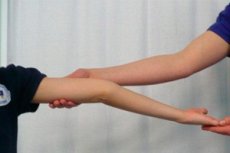Medical expert of the article
New publications
Hypermobility in children
Last reviewed: 04.07.2025

All iLive content is medically reviewed or fact checked to ensure as much factual accuracy as possible.
We have strict sourcing guidelines and only link to reputable media sites, academic research institutions and, whenever possible, medically peer reviewed studies. Note that the numbers in parentheses ([1], [2], etc.) are clickable links to these studies.
If you feel that any of our content is inaccurate, out-of-date, or otherwise questionable, please select it and press Ctrl + Enter.

Causes of hypermobility in a child
Often hypermobility is a consequence of trauma. Quite often it is a consequence of birth trauma or intrauterine developmental anomalies. Much less often this pathology is caused by genetics. In most cases, such pathology goes away on its own as the child grows up. However, there are also cases when the pathological condition only worsens, and the child needs treatment.
Symptoms of hypermobility in a child
Sometimes the only symptom that indicates a pathological condition is pain and discomfort that the child complains about. Most often, pain in the joints makes itself known. It especially intensifies during intense physical activity, and even during play or running. The pain may affect only one joint, or several at once. The severity of the pain syndrome is directly proportional to the degree and severity of physical activity. In some children, the pain is clearly localized and symmetrical, while in others it may be generalized, the source is lost.
Often, children show increased mobility in the joints against the background of hypermobility, which is manifested by fussiness, excessive mobility and activity. Such a child cannot do one thing for a long time and cannot concentrate. The educational activity of such a child also suffers. He is characterized by high distractibility, low level of concentration and attentiveness. In the presence of such two combined pathologies, it is appropriate to talk about a mental disorder, a dysfunction of the autonomic nervous system.
It is also worth noting that hypermobility in children may have some distinctive features. For example, their disease is accompanied by joint spasms. Often an inflammatory process develops that affects the connective tissue. In this case, as the child grows, the symptoms gradually decrease, until they disappear completely. Often, such a syndrome is diagnosed in children with cardiovascular diseases. Hypermobility is especially often an accompanying symptom in mitral valve disease.
Joint hypermobility in infants
In infants, hypermobility may be a sign of a neuropsychiatric disorder, autonomic dysfunction. In most cases, this disease is caused by difficulties in adaptation and postpartum stress. In most infants suffering from this pathology, the syndrome disappears within the first 6 months of life. It is also worth noting that this pathology is typical for children who have received a birth injury, or had a delay, other developmental defects.
Использованная литература


 [
[